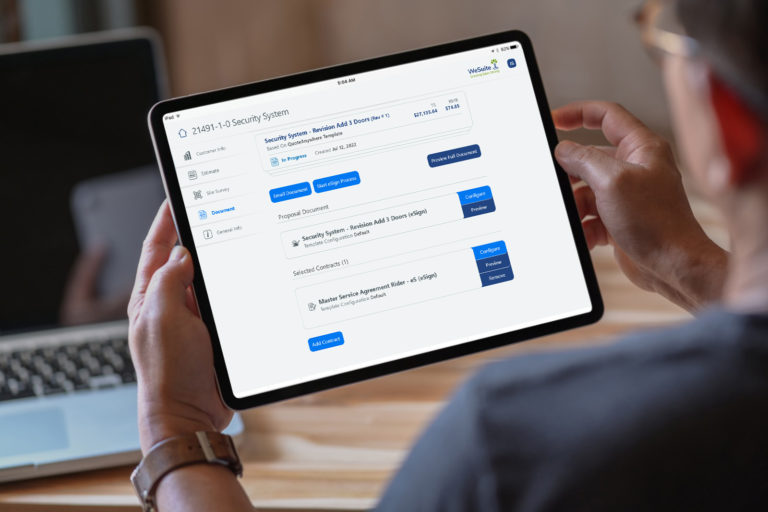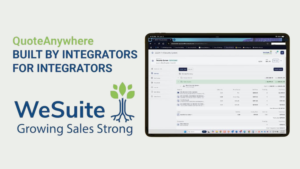5 Ways Mobile Sales Tools Pay For Themselves
A connected sales process has become vitally important to business continuity and sales success. Learn how mobile sales management tools keep sales teams selling, drive efficiencies throughout your organization and improve profitability and success…

By Tracy Larson
The stream near our family cabin is stocked with fish. But that doesn’t mean that everyone with a fly rod is catching anything. Sometimes I sit and watch people fish. The folks who are bringing home dinner know when to come, where to stand, and what bait to use. As for the others, they spend an awful lot of time hoping to get lucky and they many times – they go home hungry! It sounds a lot like security sales prospecting, doesn’t it?
The hardcore fisher-people have it down to a science, even though they must rely on their experience, rather than reporting tools, to guide them. Security salespeople have it easier. We have tools – that rely on real data – that help us figure out where to prospect next, who to talk with, priorities, the next steps and actions to take, and which deals to focus on and close or lose. The reporting capabilities of our CRM and sales management platforms guide the way. All we have to do is tap into the treasure trove of data they hold.
That’s right … reporting tools aren’t just for sales and executive management – they’re for salespeople! The best salespeople know that they benefit tremendously by understanding what their sales reporting tells them and then how to act upon this information. Here’s what you should know.
Where Should I Fish?
Even in 2020, when the sales world has changed dramatically, territory is still your territory. Assign five different salespeople to a specific territory, and they’d each approach it in their own way. Some will end up with more bites and fish than others, because they have zeroed in on the most effective prospects, prospecting activities and what those prospects really need. They are most effective because they use their experience couple with their sales reporting data to help identify the profile of customers to meet, the best markets to play in, the shortest sales cycles, the most profitable types of sales, the solutions most needed and the sales most likely to close.
Review your sales for the past year or two and sort them by different factors. Market type. Opportunity size. Security needs. Geography. Solution needs. Look for the criteria that makes the most sense in your world. Do the same with the sales projects in your pipeline and those you have won over the last 6 months. It’s time to compare and understand differences. Using that data is key in keeping your pipeline active and full.
Let’s start with close ratios. Maybe your pipeline is filled with a certain type of customer because they’re plentiful in your market. They’re easy to meet with. You think of them as your “bread and butter.” But, when you look at your sales reporting statistics you see that this customer type actually has a lower close ratio than another type of customer who you prospect less often. The reporting indicates that you should consider spending more time seeking out this other type of customer. The incremental time spent doing opportunity research and more aggressive or effective outreach to them could pay off big in more actual sales, larger accounts and accounts that really need your products and services.
How Long Should I Fish in This Pond?
What about the length of time you spend in your sales cycle from contact to contract? Focusing on the time-to-close in sales reporting is a great way to determine key factors on where to focus your efforts. Sales that you can win and close quickly give you more time to sell, increase your chances to meet and exceed quota, and may provide you more time to attend to your accounts. These sales may not represent the biggest fish in the pond however, reeling them in provides a steady revenue stream, and allows you to fit in time to hunt tuna and whales. They also provide you greater insight into what is working, and what isn’t. Understanding the time needed to spend with various prospect types and the potential payoff for your sales investment is crucial in keeping all stages of your pipeline full, active and productive, and for disengaging with those that may drag your lines and get away!
The Biggest Fish Aren’t Always the Tastiest.
Profit margins are another factor to look at. Large projects may be something you’re chasing. Let’s face it – it feels good to land a whale. But unless they have a profitable outcome and are in the wheelhouse of your engineering and installation team, they may be more effort than they’re worth. Look carefully at your sales history. If the profit margins for certain types of projects, or customers are consistently lower than you target, it’s probably time to fish in a different pond or try different bait.
And here’s one more thing to consider. Look at the value of different types of projects over their lifetime, not just at as an initial sale. Customers who invest in recurring services (“RMR” solutions), or willingly sign multi-year service contracts, may be worth far more to you than customers who make a larger initial purchase but maintain no on-going relationship. This big-picture vision applies to bid work as well. While winning a project may require you to quote initially at lower profit margins, that first project may open the door to many more opportunities with the contract holder and direct customer – especially when you’ve delivered a great job. What does that mean? In the case of general contractors, the goal is to be short-listed for additional opportunities. General contractors want to work with providers they can rely on, especially for complex integrated security solutions. For the direct customer, you have won the account and no longer have the bid requirement, in which case, you’ll make your initial short fall back over time and realize more sales at higher profits and hopefully, sell recurring service components too! Make sure you’re prioritizing the sales opportunities that provide the largest payoff in the long-term. Those customers will continue to generate revenue with minimal added sales effort, leaving you more time to expand your customer base. (Read more in our related blog post, “How to Boost Your Security Sales with Data Driven Intelligence.”)
Getting Them to Bite
Once you’ve figured out who you want your customers to be, or “what you’re fishing for,” it’s time to focus on the activities that help to close more of those sales. Once again, reporting has a story to tell.
Your CRM, along with its reporting capabilities, is the place to start. At WeSuite, WeOpportunity becomes the salesperson’s “virtual assistant,” as a CRM it keeps priorities front and center, providing reminders when it’s time to call someone back or create follow up with a specific prospect. It even helps salespeople plan, note and schedule next steps. Reporting shows which opportunities have reached a certain stage in the sales cycle, how many are in each stage and for how long. Reporting can clarify low hanging fruit just needing a little sales attention, and opportunities that may have fallen off the radar and need re-engagement. For the latter, if reporting shows that you’ve talked to all the right people and suddenly there’s been a change in their response – that they’re not calling you back – your CRM is the place to mark the opportunity as a loss. Marking opportunities as lost and selecting the specific loss reason is another great way to get sales data you can use perhaps at another date, or in identifying prospects that just aren’t right for you.
Especially at this time, a combination of CRM and sales reporting, like that you get in WeSuite’s WeEstimate can help you move sales opportunities through your sales stages and increase close ratios. Just by creating a lead and working it through the quoting stage, WeSuite returns well over 100 different data points easily used for sales reporting!
Reviewing reporting data regularly and comparing it to recent (monthly or quarterly) and longer term (last year, last two years) history, is very revealing. Seeing data trends helps us to identify things we may have missed and confirm “gut” feelings or validate other observations. Look at the sales you’ve closed and compare them to the fish that got away. What’s different about them? In order to do this, it’s important that you’re using your CRM and sales estimating platform not just to track wins, but losses, lead sources, markets, sales stages, and next actions as well.
Be sure to compare apples to apples. Look at opportunities in similar markets, of similar types, with similar budgets. What made the winning proposals successful? What solutions were sold? What were the issues you solved for these customers? Was there anything different in the process you used, or how you nurtured the relationship? Of course, no cookie cutter formula is going to work for all of your customers but, identifying trends that lead to success can help you hone your sales skills and zero in on the questioning strategies that best identified customer needs, types of products, services, solutions and pricing strategies that are most well received.
Reporting from your CRM and sales database is also a great place to begin your upselling sales initiatives. It is always important to pay attention to your customers and today, this is even more vital. Use reporting to identify where opportunities may exist within your current customer base. What are the new challenges they may be facing? How can you help? Be sure to read our blog “The Art of the Upsell” for more on this topic.
Summary
Security sales organizations invest in CRM and sales management software to enable consistency and efficiency in their sales workflow, growth in their business, and visibility into their sales world. The reporting capabilities of software like WeSuite’s WeOpportunity, WeEstimate and our new Sales Intelligence product, contribute mightily toward these goals. The key to understanding the power of sales reporting is to recognize that it isn’t just for management! If you’re a salesperson who’s fortunate enough to work at a company with a robust CRM and sales management software platform in place, you are in the best position to leverage its real-time reporting capabilities for your sales success. You’ll know how to catch more fish, guaranteed!
We Want to Know:
What’s the single most valuable reporting statistic that could help improve your sales performance?
Recent Posts

WeSuite Expands Its QuoteAnywhere to a Full-Featured Stand-Alone Sales Platform
WeSuite, a manufacturer of award-winning sales management software for security technology sales and service providers, is excited to announce the expansion of its web-based sales software, QuoteAnywhere, to a full-featured, stand-alone, lead-to-close sales platform.

WeSuite President Tracy Larson Inducted into Security Sales & Integrations Industry Hall of Fame
WeSuite, a manufacturer of award-winning sales management software for security technology sales and service providers, announced today that Tracy Larson, WeSuite President and Co-Founder, has been inducted into the Security Sales & Integration’s Industry Hall of Fame.

Are You Getting the Most Out of Your CRM? Start by Asking these 5 Simple Questions
Your sales pipeline is your lifeline. It tells you where your deals stand, where your time should go, and how close you are to hitting your number. And your CRM? It’s the tool that keeps your pipeline in check.

Is There a Secret to Closing Security Sales Faster? Here Are Seven!
Pushy, high-pressure sales tactics turn off buyers – we’ve all been there! Fortunately, you can increase your on-the-spot close ratio by being buyer and solution oriented with sales automation software like QuoteAnywhere from WeSuite to support your sales efforts.
